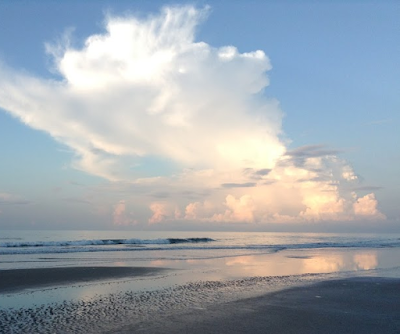Elves and the Ocean: Beware of the Sea
I had never seen a sunrise. I just didn’t see the point. Watching a sunrise would be just as exciting as watching a sunset, which, though pretty, wasn’t exactly a novel sight. Then there was the problem of getting up early enough to catch even the last rays of color before the sky turned into a dull blue backdrop. But when I finally caught sight of my first sunrise, it was magical. That’s because it was set above a mirror of clear, crystal waves advancing one by one along the shoreline. My first sight of the sea.
What met my eyes was a crystal cloud displayed like glass, accented with rays of light trying to escape from its overbearing presence. I saw the tide leaving the shore, the retreating waves crashing inwards in some feeble show of resistance. I saw the deep blue waves, not only blue, but many colors both reflecting and drawing out the sunrise above. To say it made an impression would be an understatement. Tolkien’s elves experience similar feelings for the sea. But, unlike me, their feelings stretch much farther than mine ever will.
The different types of elves, or rather the Eldar, are vastly different in all ways except for their love of the sea. However, their love manifests itself also in vastly different ways. Of the three types of Eldar that went over the sea, the Noldor, Vanyar, and Teleri, the Teleri loved the sea the most. So much, in fact, that they dwelt by it in the city and haven of Alqualondë. Though extreme beauty and light were within their reach they most often chose to stay by the sea and sail upon it in their swan ships.
“There they dwelt, and if they wished they could see the light of the Trees, and could tread the golden streets of Valmar and the crystal stairs of Tirion upon Túna, the green hill; but most of all they sailed in their swift ships on the waters of the Bay of Elvenhome, or walked in the waves upon the shore with their hair gleaming in the light beyond the hill” (Silmarillion 61).
In the others their love of the sea wasn’t as apparent, but when most of the Noldor returned to Middle Earth from Aman and became exiled they constantly yearned for it and the land of Aman that lay beyond. Of the Grey-elves, the elves of the Eldar that had never seen the light of the two trees in the first place, their connection to the sea was a little different. As Legolas, a Grey-elf in the Lord of the Rings, later found out, the Sindar felt no desire to see or explore the sea, but once they saw it once, they could never rest or forget it.
“In the hearts of the Exiles the yearning for the Sea was an unquiet never to be stilled; in the hearts of the Grey-elves it slumbered, but once awakened it could not be appeased” (App F).
Legolas had, however, been warned before.
 | ||||
| "Eärendil the Mariner" by Ted Nasmith |
Galadriel sent a message to him in The Two Towers warning if he should see the sea or hear the seagulls, he would never again be content in Mirkwood or any other forest which was or would be his home (TTT 112). Consequently, when Legolas accidently came into sight of the sea he yearned for it ever after until he was finally able to cross back over to Aman along with Gimli when Aragorn died in the Fourth Age 119-120. There his desire was at last put to rest. Of the elves that shared this desire, all slowly followed their hearts and passed over the sea, where they could be at rest, until, at last, no elves were left in Middle Earth and men ruled over it.
Works Cited
Nasmith, Ted. Eärendil the Mariner. 1998. Ted Nasmith. Web. 19 December, 2018.
Tolkien, J.R.R. The Return of the King. 1955. Del Rey. Date accessed Dec 23, 2018.
Tolkien, J.R.R. The Silmarillion. 1977. Del rey. Edited by Christopher Tolkien. Date accessed
Dec 23, 2018.
Tolkien, J.R.R. The Two Towers. 1955. Del Rey. Date accessed Dec 23, 2018.
Permission for use granted by Ted Nasmith via Email on Dec 20, 2018.



Comments
Post a Comment